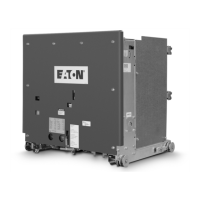28
Instruction Booklet IB131006EN
Effective March 2019
Instructions for installation,
operation, and maintenance of type
VCP-W vacuum circuit breakers
EATON www.eaton.com
4. Initial inspection and installation
4.1 Introduction
m WARNING
BEFORE PLACING THE CIRCUIT BREAKER IN SERVICE, CAREFULLY FOLLOW
THE INSTALLATION PROCEDURE GIVEN BELOW. NOT FOLLOWING THE
PROCEDURE CAN FAIL TO UNCOVER SHIPPING DAMAGE THAT MAY
RESULT IN INCORRECT CIRCUIT BREAKER OPERATION LEADING TO DEATH,
BODILY INJURY, AND EQUIPMENT DAMAGE.
Before attempting to put a circuit breaker in service, it should be
carefully examined and operated manually and electrically. In addi-
tion, carefully examine the breaker for loose or obviously damaged
parts. The following information is a guide for performing recom-
mended checks and tests.
4.2 Manual operation check
Refer to Figures 7 and 8 and then proceed by placing the main-
tenance tool into the manual charge socket opening. Charge the
closing springs with about 38 up and down strokes of the handle.
When charging is complete, the closing crank goes over center
with an audible CLICK and the springs Charged/Discharged indicator
shows “Charged.”
NOTICE
IF THE SPRINGS ARE TO BE CHARGED ON A CLOSED CIRCUIT BREAK-
ER, NO CLICK IS HEARD AT THE END OF CHARGING OPERATION.
DISCONTINUE CHARGING AND REMOVE THE MAINTENANCE TOOL AS
SOON AS “CHARGED” FLAG IS FULLY VISIBLE. CONTINUED ATTEMPTS TO
CHARGE FURTHER MAY RESULT IN DAMAGE TO THE MECHANISM.
Remove the maintenance tool. Close and trip the circuit breaker.
Repeat several times.
4.3 Vacuum interrupter integrity
Using a dry, lint free cloth or paper towel, clean all the accessible
insulating surfaces of the pole units. Conduct a vacuum interrupter
integrity check as described in Section 6.
4.4 Insulation
Check the circuit breaker’s primary and secondary insulation as
described in Section 6.
4.5 Contact erosion and wipe
Manually charge the closing springs and close the circuit breaker.
Check contact erosion and wipe as described in Section 6.
4.6 Primary circuit resistance
Check the primary circuit resistance as described in Section 6. The
resistance should not exceed the values specified. Record the values
obtained for future reference.
4.7 Nameplate
Compare the circuit breaker nameplate information with switchgear
drawings for compatibility.
Figure 8. Type VCP-W circuit breaker manual charging handle in
use.
4.8 Electrical operation check
After having completed all previous checks and tests, the circuit
breaker is ready to be operated electrically. It is preferred that this
check be made with the circuit breaker in a TEST position or by using
a test cable, if the circuit breaker is outside the cell structure.
m CAUTION
BEFORE INSERTING THE CIRCUIT BREAKER, EXAMINE THE INSIDE OF
THE CELL STRUCTURE FOR EXCESSIVE DIRT OR ANYTHING THAT MIGHT
INTERFERE WITH THE CIRCUIT BREAKER MOVEMENT.
m WARNING
EXTREME CAUTION MUST BE EXERCISED TO INSURE THAT PRIMARY
CIRCUITS ARE NOT ENERGIZED WHILE CHECKS ARE PERFORMED IN THE
CIRCUIT BREAKER COMPARTMENT. FAILURE TO DO SO MAY RESULT IN
PERSONAL INJURY OR DEATH.
The circuit breaker is normally tested electrically in its cell structure
in the TEST position. To achieve the TEST position, first determine
if the breaker cell has a BPI Pan Assembly, Figure 12 or a non-BPI
Pan Assembly, Figure 13. Then follow the appropriate instructions in
section 4.8.1 to move/lever the circuit breaker into the TEST position.
4.8.1 Circuit breaker insertion and removal
m CAUTION
DO NOT USE ANY TOOL OTHER THAN THE LEVERING-IN CRANK PROVIDED
TO LEVER THE CIRCUIT BREAKER FROM TEST OR CONNECTED POSITIONS.
CORRECT OPERATION OF SOME OF THE INTERLOCKS IS DEPENDENT ON
USE OF THE PROVIDED LEVERING-IN CRANK. PERSONAL INJURY OR
EQUIPMENT DAMAGE COULD RESULT FROM THE USE OF A TOOL OTHER
THAN THE PROPER LEVERING-IN CRANK.

